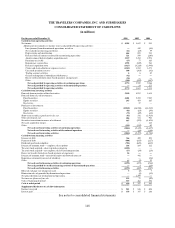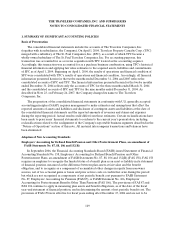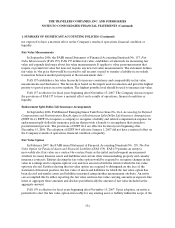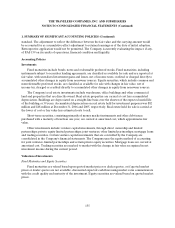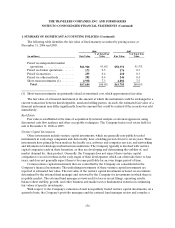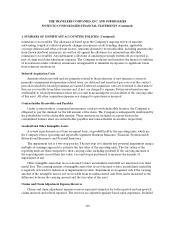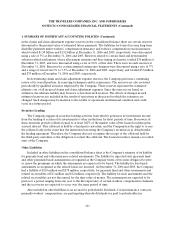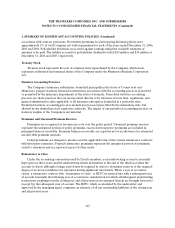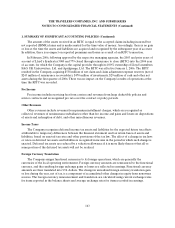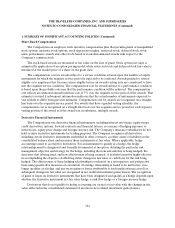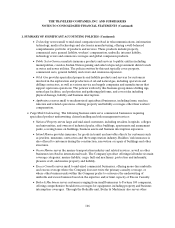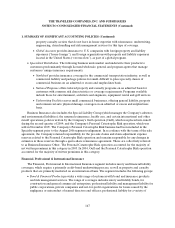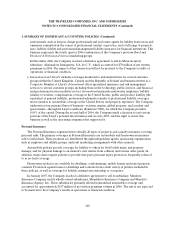Travelers 2006 Annual Report Download - page 170
Download and view the complete annual report
Please find page 170 of the 2006 Travelers annual report below. You can navigate through the pages in the report by either clicking on the pages listed below, or by using the keyword search tool below to find specific information within the annual report.THE TRAVELERS COMPANIES, INC. AND SUBSIDIARIES
NOTES TO CONSOLIDATED FINANCIAL STATEMENTS (Continued)
158
1. SUMMARY OF SIGNIFICANT ACCOUNTING POLICIES (Continued)
The Company’s process for reviewing invested assets for impairments during any quarter includes the
following:
•Identification and evaluation of investments that have possible indications of other-than-temporary
impairment, which includes an analysis of investments with gross unrealized investment losses that
have fair values less than80% of cost for six consecutive months or more;
•Review of portfolio manager(s) recommendations for other-than-temporary impairments based on
the investee’s current financial condition, liquidity, near-term recovery prospects and other factors;
•Consideration of evidentialmatter, including an evaluation of factors or triggers that may cause
individual investments toqualify as having other-than-temporary impairments; and
•Determination of the status of each analyzed investment as other-than-temporary or not, with
documentation of the rationale for the decision.
Sales of Temporarily Impaired Invested Assets
The Company may, from time to time, sell invested assets subsequent to the balance sheet date that
were considered temporarily impaired at the balance sheet date for several reasons. For all subsequent
sales of invested assets that were considered temporarily impaired at the balance sheet date, theCompany
contemporaneously documents its rationale for its change in intentor ability to hold to recovery. The
rationale for the change in the Company’s ability and intent generally focuses on changes in the economic
facts and circumstances related to the invested asset subsequent to the balance sheet date, significant
unforeseen changes in the Company’s liquidity needs, or changes in tax laws or the regulatory
environment.
Fixed Maturities and Equity Securities
An investment in a fixed maturity or equity security which is available for sale isimpaired if its fair
value falls below its cost or new cost basis and the decline is considered to be other-than-temporary. A
fixed maturity security is other-than-temporarily impaired if it is probable that the Company will not be
able to collect all amounts due under the security’s contractual terms or where the Company does not have
the intent to hold the security. Equity securities are other-than-temporarily impaired when it becomes
apparent that the Company will not recover its cost over the expected holding period. Further, for
securities expected to be sold, another-than-temporary impairment charge is recognized if the Company
does not expect the fair value of a security to recover prior to the expected date of sale. Additionally, for
certain securitized financial assets with contractual cash flows (including asset-backed securities), the
Company periodically updates its best estimate of cash flows over the life of the security. If management
determines thatthe fair value of a securitized financial asset isless than its carrying amountand there has
been a decrease in the present value of the estimated cash flows since the last revised estimate, considering
both timing and amount, then an other-than-temporary impairment is recognized.
Other Investments
Real Estate Investments
The carrying value of a real estate property is reviewed for impairment when events or changes in
circumstances indicate that the carrying amount may not be recoverable. The review for impairment
includes an estimate of the undiscounted cash flows expected to result from the use and eventual
disposition of the real estate property. An impairment loss is recognized if the expected future
undiscounted cash flows are less than the carrying value of the real estate property. The impairment loss is
measured as the amount by which the carrying amount exceeds fair value.


